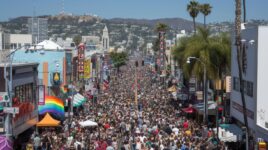
Like Those Celebrated With an Annual Day of Visibility
The concept of an annual day of visibility holds great significance in celebrating various groups and communities, shining a light on their unique struggles and achievements. These designated days bring attention to marginalized communities, providing a platform for recognition, advocacy, and empowerment. From Pride Month for the LGBTQ+ community to International Women’s Day and Black History Month, these annual celebrations serve as important reminders of the ongoing need for inclusivity and equality.
Throughout history, annual days of visibility have played a pivotal role in raising awareness and promoting acceptance for marginalized groups. The origins and evolution of these celebrations have demonstrated the power of visibility in challenging stereotypes and fostering understanding. By delving into the roots of these recognized days, we can explore their impact on shaping societal attitudes and perceptions towards diverse communities.
Visibility is essential for marginalized communities as it provides a sense of validation and representation, helping to combat discrimination and promote inclusivity. An annual day of visibility serves as an opportunity to amplify the voices of these communities, highlighting their contributions to society while addressing the challenges they face. By shedding light on their experiences, these celebrations pave the way for greater empathy and support.
The impact of annual days of visibility cannot be overstated, as they have contributed to significant advancements in promoting equality and recognition for various communities. Success stories stemming from these designated days showcase tangible progress in dismantling barriers and driving positive change. Through increased visibility, these communities have been able to advocate for their rights and create more inclusive spaces within society.
From Pride parades to awareness seminars, annual days of visibility are celebrated through a variety of events that serve as platforms for education, empowerment, and solidarity. These gatherings not only foster a sense of community but also inspire activism and allyship among those seeking to support marginalized groups. Through such collective efforts, annual days of visibility have become catalysts for lasting change within society.
History of Annual Days of Visibility
The history of annual days of visibility is rich and diverse, encompassing a wide range of communities and social movements. These designated days have played a crucial role in raising awareness, promoting inclusivity, and celebrating the unique contributions of marginalized groups. The origins of annual days of visibility can be traced back to the need for increased recognition and representation for these communities.
One of the earliest recognized annual days of visibility is International Women’s Day, which has its roots in the early 20th century labor movement and has since evolved into a global celebration of women’s achievements and a call to action for gender equality. Similarly, Black History Month, originally established as “Negro History Week” in 1926 by historian Carter G. Woodson, has grown into a month-long observance that highlights the achievements and contributions of African Americans throughout history.
In the LGBTQ+ community, Pride Month commemorates the Stonewall Riots of 1969, which served as a catalyst for the modern gay rights movement. What began as a commemoration of this pivotal event has evolved into a month-long celebration of LGBTQ+ identities, culture, and advocacy for equal rights. These examples demonstrate how annual days of visibility have evolved over time to become significant cultural touchstones and platforms for advocacy and education.
The impact of these annual days of visibility on their respective communities cannot be understated. They serve as important moments for reflection, education, and activism. These designated days provide opportunities for individuals to come together in solidarity to celebrate their identities while also advocating for greater recognition and equality on behalf of their communities.
Additionally, annual days of visibility have played an essential role in challenging societal norms and shaping public discourse around issues related to diversity and inclusion. By providing dedicated time to commemorate these communities’ experiences, struggles, triumphs, and ongoing challenges are brought to the forefront in powerful ways that demand attention and change.
Ultimately, the establishment and evolution of annual days of visibility have been instrumental in highlighting the historical significance and contemporary relevance of various marginalized groups. These celebrations continue to uplift voices that may otherwise go unheard while fostering collective efforts towards greater representation, acceptance, understanding, and support for these vital communities.
- The impact on society
- Contributions made by different communities
- Intersectional nature
- Connection between past & present
- Importance beyond just celebration
Importance of Visibility
Visibility plays a crucial role in the lives of marginalized communities, as it helps to bring attention to their experiences, struggles, and achievements. It is through visibility that these communities can challenge stereotypes, combat discrimination, and advocate for equality.
An annual day of visibility serves as an opportunity to amplify the voices of these communities and shed light on their unique circumstances. This section will explore the importance of visibility for marginalized communities and how an annual day of visibility can help raise awareness and promote inclusivity.
Challenging Stereotypes and Misconceptions
One of the primary benefits of visibility for marginalized communities is the opportunity to challenge stereotypes and misconceptions that may exist. By sharing personal stories, achievements, and contributions, these communities can dismantle harmful narratives and present a more accurate portrayal of their experiences. This not only creates a more inclusive society but also fosters greater understanding among individuals who may not be familiar with or have preconceived notions about these communities.
Combatting Discrimination
Visibility also plays a significant role in combating discrimination and prejudice faced by marginalized communities. When the experiences and challenges of these communities are brought to light, it becomes harder to ignore or dismiss the systemic issues they face. This increased awareness can lead to meaningful conversations about addressing discrimination at various levels, including policies, social attitudes, and behavioral changes.
Promoting Inclusivity
In addition to challenging stereotypes and combating discrimination, visibility promotes inclusivity by creating spaces where marginalized voices are heard and valued. An annual day of visibility serves as a reminder that these communities not only deserve recognition but also have important contributions to make towards building a more inclusive society. It encourages individuals to actively engage with diverse perspectives, practices, and traditions that they may not have been exposed to before.
Raising Awareness for Specific Issues
Another critical aspect of visibility is its ability to raise awareness for specific issues affecting marginalized communities. Whether it’s advocating for LGBTQ+ rights, gender equality, racial justice, disability rights, or other important causes, an annual day of visibility draws attention to these concerns on a larger platform. Through events like parades, seminars, rallies, and educational initiatives during such days provide opportunities for education on important topics relating to these issues.
The significance of maintaining visibility for marginalized groups cannot be overstated; ongoing efforts toward achieving this goal demonstrate dedication toward promoting empathy amongst all members of society while validating the existence and importance diverse groups play in shaping our world.
Impact of Annual Days of Visibility
Annual days of visibility play a crucial role in impacting the perception and treatment of the communities they celebrate. By shining a spotlight on marginalized groups and raising awareness about their experiences, challenges, and contributions, these annual observances have contributed to important progress and change. From shifting societal attitudes to influencing policies and laws, the impact of annual days of visibility is significant.
Changing Perceptions
One of the most notable impacts of annual days of visibility is the way they have contributed to changing societal perceptions about marginalized communities. These observances provide an opportunity for people to learn about the history, struggles, and achievements of these communities, which can challenge stereotypes and prejudices. As a result, individuals who may have held negative or uninformed views about these groups are given the chance to develop a better understanding and empathy.
Driving Policy Changes
In addition to altering public perceptions, annual days of visibility have also played a role in driving policy changes that benefit the communities being celebrated. For example, International Women’s Day has been instrumental in bringing attention to women’s rights issues and advocating for policy changes related to gender equality, education, and healthcare. Similarly, Pride Month has led to advancements in LGBTQ+ rights through activism and advocacy efforts that are amplified during this time.
Empowering Marginalized Communities
These annual observances have also empowered marginalized communities by providing a platform for their voices to be heard and their stories to be shared. The visibility generated by these events has given individuals within these communities greater confidence in expressing themselves authentically while fostering a sense of unity among members. This empowerment has led to increased participation in social and political movements aimed at achieving equal rights and opportunities.
Fostering Understanding and Support
Another important impact of annual days of visibility is their ability to foster greater understanding and support for the communities being celebrated. By highlighting the diverse experiences within these groups, as well as their unique contributions to society, these observances encourage people from all walks of life to stand in solidarity with marginalized communities. This support can lead to tangible benefits such as improved access to resources, services, and protections for individuals who have historically been underserved.
Creating Lasting Change
Ultimately, the impact of annual days of visibility extends beyond just a single day or month-long celebration. It paves the way for lasting change by creating momentum that continues throughout the year. Successful outcomes like new legislation protecting minority rights or increased representation in mainstream media are indicative of this sustained impact resulting from annual observances dedicated to raising awareness about marginalized communities.
Examples of Celebrated Days
Annual days of visibility hold great significance in shining a spotlight on communities and groups that have historically faced marginalization and discrimination. These dedicated days provide a platform for raising awareness, celebrating diversity, and advocating for the rights of these communities. Pride Month, International Women’s Day, Black History Month, and other similar observances are prime examples of annual days of visibility that play a crucial role in promoting inclusivity and equality.
Here are some specific annual days of visibility that are celebrated to honor and support various communities:
- Pride Month: Pride Month is an annual celebration that takes place in June to honor the LGBTQ+ community. It commemorates the Stonewall Riots, which served as a catalyst for the gay rights movement. Pride Month is marked by parades, festivals, and events that promote LGBTQ+ visibility and advocate for equal rights and acceptance.
- International Women’s Day: Celebrated on March 8th, International Women’s Day is a global day honoring the social, economic, cultural, and political achievements of women. It also serves as a call to action for accelerating gender parity. This day is observed with events and initiatives aimed at promoting gender equality and celebrating the contributions of women to society.
- Black History Month: In the United States and Canada, Black History Month is celebrated in February to recognize the central role of African Americans in U.S. history. It is a time to acknowledge the struggles and triumphs of the Black community while highlighting their impact on society. Various events such as lectures, exhibits, and performances take place during this month to honor Black history.
Other examples include Native American Heritage Month (in November), Asian Pacific American Heritage Month (in May), Hispanic Heritage Month (from September 15th to October 15th), among others. Each of these annual observances serves as an opportunity to celebrate the rich cultural heritage and contributions of these diverse communities.
These specific annual days of visibility hold immense significance as they provide a platform for education, advocacy, and empowerment. They help raise awareness about the challenges faced by these communities while also celebrating their accomplishments. Moreover, they serve as an occasion for individuals from all walks of life to come together in support of diversity and inclusion.
As we continue to celebrate these annual days of visibility, it is essential to recognize that there are still many challenges faced by these communities in achieving full equality and recognition. Advocacy efforts must persist beyond these designated times to ensure ongoing progress towards inclusivity on a year-round basis.
Ultimately, these annual celebrations not only honor the past struggles but also inspire hope for a more inclusive future where all individuals can thrive without fear or discrimination based on their identity or background.
Challenges Faced
Annual days of visibility play a crucial role in promoting awareness and recognition for marginalized communities, but the road to visibility is often fraught with challenges and obstacles. One of the primary challenges faced by these communities is societal discrimination and stigmatization. Many groups that are celebrated with annual days of visibility, like the LGBTQ+ community, people of color, individuals with disabilities, and others, continue to experience prejudice and bias in various aspects of their lives.
Lack of representation in mainstream media and popular culture is another obstacle faced by these communities. In many cases, the stories and experiences of marginalized groups are overlooked or misrepresented, leading to a lack of understanding and empathy from the wider population. This perpetuates stereotypes and further contributes to their marginalization.
Furthermore, institutional barriers such as discriminatory policies, unequal access to resources, and systemic injustices present significant hurdles for these communities in achieving visibility and recognition. The effects of such barriers can be far-reaching, impacting employment opportunities, healthcare access, educational attainment, and overall well-being.
An annual day of visibility can help address these challenges by providing a platform for advocacy and awareness-building. It serves as an opportunity to highlight the issues faced by these communities and educate the public about their unique experiences. Additionally, it can lead to policy changes and initiatives that aim to dismantle discriminatory practices and promote inclusivity.
Moreover, through the celebration of an annual day of visibility, individuals within these communities are empowered to share their stories and assert their identities without fear of judgment or discrimination. This sense of solidarity fosters a supportive environment that encourages self-expression and collective action toward positive change.
In order to truly address the challenges faced by marginalized communities in achieving visibility and recognition, ongoing efforts beyond an annual day of visibility are essential. Continued advocacy, allyship from those outside the respective communities, commitment to policy reform, and amplification of diverse voices are fundamental in creating lasting impact towards greater inclusivity.
| Challenges Faced | How Annual Day Can Address These Issues |
|---|---|
| Societal discrimination | Provides a platform for advocacy & awareness-building |
| Lack of representation in media | Empowers individuals within these communities to share their stories |
| Institutional barriers & systemic injustices | Leads to policy changes & initiatives promoting inclusivity |
Celebrations and Events
Annual days of visibility are celebrated in a variety of ways, with events and activities that aim to promote awareness and support for the communities being honored. These celebrations play a crucial role in raising visibility and fostering inclusivity for marginalized groups, contributing to greater acceptance and understanding on a societal level.
One of the most common forms of celebration for annual days of visibility is through parades and marches. These large-scale events bring together members of the community, allies, and supporters to demonstrate unity and solidarity. Parades often feature colorful displays, music, and lively festivities that create a sense of pride and empowerment within the community. This public display of visibility sends a powerful message to society about the presence and importance of these communities.
In addition to parades and marches, seminars and conferences are another important aspect of celebrating annual days of visibility. These events provide opportunities for education, discussion, and advocacy. Seminars often feature guest speakers, panel discussions, workshops, and presentations that address relevant issues faced by the community. By providing a platform for dialogue and learning, these events contribute to greater awareness and understanding among attendees.
Furthermore, artistic and cultural celebrations are also commonly held to mark annual days of visibility. These can include art exhibitions, film screenings, theater performances, or music festivals that showcase the talents and creativity within the community. Cultural celebrations not only serve as a means of expression but also highlight the rich contributions that these communities make to society.
Community outreach activities such as volunteer work or fundraising initiatives are another way in which annual days of visibility are commemorated. These efforts emphasize the spirit of service within the community while also raising awareness among the general public about social issues impacting these groups.
Finally, virtual events have become increasingly popular due to their accessibility. Online discussions, webinars, social media campaigns, and virtual gatherings enable people from diverse geographical locations to participate in celebrating annual days of visibility. This digital approach has proven especially valuable in reaching a wider audience and engaging individuals who may not be able to attend physical events.
Advocacy and Activism
The establishment and recognition of annual days of visibility for marginalized communities are often the result of fervent advocacy and activism. These efforts play a crucial role in driving progress and change by bringing attention to the struggles and achievements of these communities, ultimately leading to greater visibility and acceptance. Advocacy and activism serve as catalysts for change, pushing for recognition, representation, and equality for those who have historically been marginalized or discriminated against.
One significant aspect of advocacy and activism in the establishment of annual days of visibility is the persistent push for awareness and recognition. Activists within these communities work tirelessly to raise awareness about the unique challenges they face, as well as their contributions to society. This tireless effort helps highlight the need for dedicated days of visibility to celebrate their history, culture, and achievements.
Furthermore, advocacy and activism play a vital role in challenging societal norms and prejudices that contribute to the marginalization of certain groups. Through organized protests, campaigns, educational initiatives, and policy advocacy, activists can effect real change in how these communities are perceived and treated. This not only leads to greater understanding but also fosters an environment where inclusivity becomes a priority.
In addition to raising awareness and challenging societal norms, advocacy and activism contribute to legislative changes that support annual days of visibility. Through lobbying efforts, community organizing, and grassroots movements, activists have been instrumental in advocating for official recognition at local, national, or even international levels. By gaining official recognition, these annual days become more than just symbolic gestures; they become opportunities for systemic change through policy implementations.
Overall, advocacy and activism are essential components in the establishment and recognition of annual days of visibility like those celebrated with an annual day of visibility. These efforts not only drive progress but also serve as a testament to the resilience and determination of these communities in their pursuit of equality and acceptance.
As we continue to recognize various annual days of visibility around the world, it is important to acknowledge the pivotal role that advocacy and activism play in amplifying voices that have long been silenced.
Global Impact
Annual days of visibility have played a pivotal role in promoting greater acceptance and understanding of diverse communities on a global scale. These designated days provide an opportunity for individuals and organizations around the world to come together in celebration and advocacy, ultimately contributing to positive societal change.
One of the most prominent examples of a globally recognized annual day of visibility is Pride Month, which celebrates the LGBTQ+ community and their contributions to society. This month-long celebration takes place in many countries, with parades, events, and educational initiatives aimed at increasing awareness and support for LGBTQ+ rights. The global impact of Pride Month has been significant, leading to greater visibility and acceptance for LGBTQ+ individuals in numerous parts of the world.
Similarly, International Women’s Day serves as an annual day of visibility that has garnered widespread global support. Celebrated on March 8th each year, this day recognizes the social, economic, cultural, and political achievements of women while also raising awareness about gender equality issues. Through various events, campaigns, and initiatives organized internationally, International Women’s Day has had a profound impact in highlighting women’s rights and advocating for gender parity.
The existence of Black History Month also demonstrates the global impact of annual days of visibility. While its origins are rooted in the United States, Black History Month has gained recognition in other countries as well. Throughout February, various nations spotlight the contributions and achievements of people of African descent through educational programs, cultural events, and discussions about racial equality. This observance has undoubtedly helped foster greater understanding and appreciation for Black history on a global scale.
Additionally, annual days like International Day Against Homophobia, Transphobia & Biphobia (IDAHOT) and International Day of Persons with Disabilities have made strides in promoting inclusivity at an international level. By providing a platform for advocacy and education on these specific issues, these annual days have contributed to conversations surrounding discrimination against marginalized groups worldwide.
The impact of these annual days of visibility extends beyond individual celebrations; they serve as catalysts for crucial conversations about diversity and inclusion on a global stage. As societies continue to strive towards equality and acceptance for all individuals regardless of their background or identity, the significance of such annual observances becomes even more evident. Ultimately, their influence contributes to fostering greater acceptance and understanding among diverse communities worldwide.
Conclusion
In conclusion, annual days of visibility serve as an essential platform for celebrating and recognizing marginalized communities, shedding light on their struggles, achievements, and contributions to society. These designated days not only provide a sense of validation and pride for the communities being celebrated but also play a crucial role in promoting inclusivity and equality.
The history of annual days of visibility has shown that these observances have the power to bring about positive change by raising awareness, challenging stereotypes, and advocating for equal rights. From the inception of Pride Month for the LGBTQ+ community to the establishment of International Women’s Day and Black History Month, these annual celebrations have paved the way for progress and social justice.
Visibility is paramount for marginalized communities as it helps combat discrimination, ignorance, and prejudice. Through increased visibility, these communities can find support, allyship, and understanding while also inspiring individuals to be proud of their identities. An annual day of visibility provides a platform for these voices to be heard and their stories to be shared with the world.
While there have been significant strides in achieving visibility for various communities through annual days of celebration, challenges still exist in the form of systemic discrimination, lack of representation, and societal barriers. It is crucial to continue advocating for recognition and support while addressing these issues to ensure that all individuals feel seen, heard, and valued.
In essence, annual days of visibility are not just about celebrating diversity; they are about fostering a more inclusive society where everyone feels respected and empowered regardless of their background or identity. As we move forward, let us continue to show our solidarity with marginalized communities by supporting their initiatives beyond just their designated day.
Only then can we truly work towards creating a world where everyone feels like those celebrated with an annual day of visibility – seen, heard, and valued.



